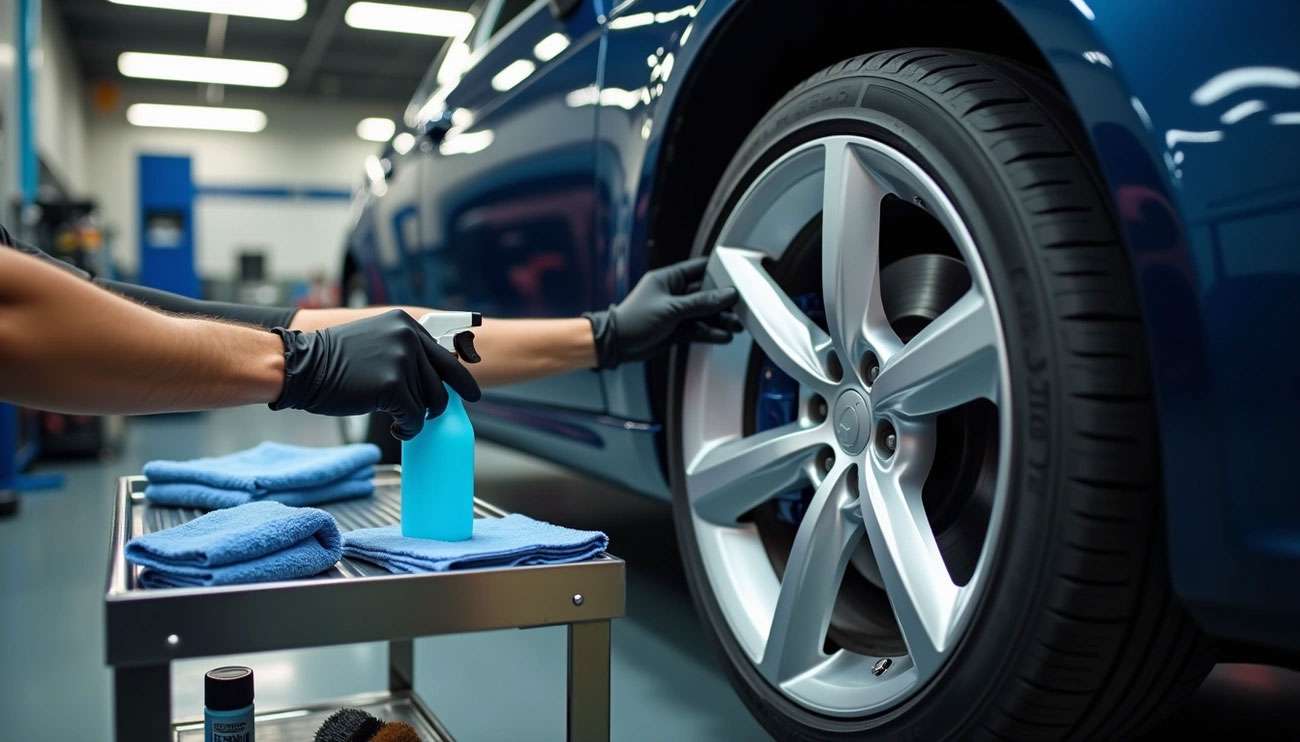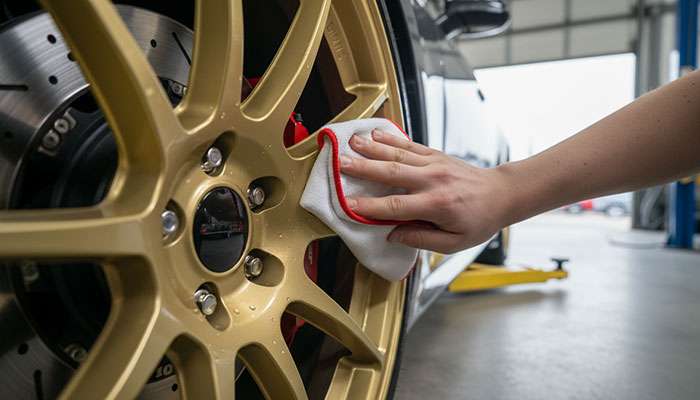
Dirty wheels destroy your vehicle's appearance faster than any other single factor. Most drivers overlook proper wheel maintenance, but this neglect creates serious long-term damage and ruins that sharp, professional look you want.
Wheel maintenance directly impacts your vehicle's safety, performance, and longevity. Regular wheel washing prevents brake dust, dirt, and grime buildup that causes corrosion and permanent damage over time. The right cleaning products dissolve contaminants effectively while protecting your wheels against future corrosion.
We recommend washing your wheels every 1-2 weeks to prevent harmful buildup. Perform visual inspections at least monthly and before any long trips. pH-balanced, non-acidic cleaners protect wheel finishes while removing brake dust and road salt efficiently.
This guide shows you exactly how to maintain your wheels like a professional. You'll learn the best cleaning products to use and discover proven maintenance strategies that extend wheel life while keeping your vehicle looking its absolute best.
Regular inspection forms the foundation of effective wheel maintenance. Check your wheels at least every two weeks, especially before long trips or high-speed driving. Remove wheels annually for complete inspection, including inner wall examination.
Examine each wheel carefully for hairline cracks, which typically start small but compromise structural integrity. These fractures most commonly appear around lug nut holes and valve stems. Even minor cracks demand immediate attention since they can develop into serious safety hazards.
Search for bends or warping along rim edges. Pothole impacts and curb strikes often distort the wheel's circular shape. These deformations create vibrations most noticeable at 55-70 mph. Small bends under an eighth inch might be repairable, while anything larger usually requires wheel replacement.
Look for corrosion signs, which appear as white powdery spots on alloy wheels or reddish-brown stains on steel components. Road salt and harsh weather accelerate this damage, particularly around lug nut seats and bead areas.
Different finishes require specific inspection approaches. Chrome wheels develop pitting or corrosion from road salt exposure. Powder-coated wheels show chips that expose underlying metal.
Clear-coated wheels display bubbling or peeling as early warning signs. Painted wheels reveal color deterioration or flaking paint when protection fails.
PVD (physical vapor deposition) finished wheels need special attention because topcoat damage can void warranties. Raw aluminum wheels without protective coating suffer oxidation and pitting more readily.
Watch for abnormal widening of tread grooves or spaces between tread blocks, which indicates aging tires. Sidewall bulges signal carcass damage and create dangerous conditions at higher speeds.
Monitor for persistent air leaks despite regular inflation, as this often means wheel damage. Uneven tire wear patterns frequently reveal alignment problems caused by bent or damaged wheels.
Catching wheel problems early prevents expensive repairs and maintains safe, efficient vehicle operation.

When it comes to wheel cleaning, the right approach makes the difference between protecting your investment and causing expensive damage. Brake dust contains metal particles that permanently etch wheel surfaces when left unattended. Regular cleaning prevents this buildup from becoming a costly problem.
Selecting the proper cleaner protects your wheels while delivering the cleaning power you need. Non-acidic, pH-balanced cleaners safely dissolve contaminants without harming protective coatings. These specialized formulas remove brake dust effectively, unlike household cleaners that contain harsh chemicals which can damage wheel finishes.
For light brake dust accumulation, neutral-based wheel cleaners provide sufficient cleaning power. Heavy buildup requires alkaline wheel cleaners that offer stronger dissolving action. The key is matching the cleaner strength to your specific cleaning needs.
Using the wrong cleaning tools creates permanent scratches that destroy your wheel's appearance. Standard household brushes damage delicate wheel surfaces, so choose brushes designed specifically for automotive use. Quality wheel brushes feature soft microfiber or flagged tip bristles that reach tight spaces without causing harm.
Boar's hair brushes work excellently on delicate finishes, while stiff nylon bristles handle rubber tire cleaning better. The investment in proper tools pays off with wheels that maintain their pristine appearance.
Proper drying prevents water spots and streaking that can ruin your cleaning efforts. Always dry your wheels with a dedicated microfiber towel to maintain that spotless, scratch-free finish. High GSM microfiber between 600-1200 grams per square meter provides optimal absorbency while remaining gentle on wheel surfaces.
Use separate towels for wheel cleaning to avoid transferring brake dust to your vehicle's paint. This simple step prevents cross-contamination and keeps your entire vehicle looking professional.
Protection after cleaning extends the time between maintenance sessions and preserves your wheels' appearance. Protective coating application reduces future cleaning requirements while keeping wheels looking showroom-fresh longer. Quality wheel sealants repel brake dust, making subsequent cleanings require only soap and water.
Reapply wheel sealant every 2-3 months for maximum protection. This schedule maintains the protective barrier that keeps your wheels looking their best with minimal effort.
Wheel maintenance goes far beyond appearance. The mechanical aspects directly affect your vehicle's handling, ride comfort, and safety on the road.
Proper tire pressure maintains optimal contact between your tires and the road surface. Under-inflated tires wear unevenly, reduce fuel efficiency, and create unsafe handling characteristics. Over-inflation produces a harsh ride and causes premature center tread wear.
Check pressure when tires are cold, before driving. Temperature changes affect pressure readings—tires lose approximately 1 PSI for every 10-degree temperature drop. Always maintain pressure levels specified in your owner's manual or door jamb sticker.
Correct lug nut torque prevents wheel loosening and avoid damage from over-tightening. Always use a calibrated torque wrench set to your manufacturer's recommended specifications. Start by hand-tightening lug nuts in a star or cross pattern, then finish with the torque wrench. Both under-torquing and over-torquing create equally serious problems. Recheck your torque settings after driving 50-100 miles.
Balanced wheels eliminate vibrations that cause premature tire wear and uncomfortable driving. Steering wheel vibration indicates front wheel imbalance, while seat vibration points to rear wheel issues. Schedule wheel balancing during tire rotations or whenever you notice unusual vibrations. This service extends tire life, improves vehicle handling, and increases fuel efficiency.
Misaligned wheels create uneven tire wear and compromise vehicle safety. Proper alignment distributes your vehicle's weight evenly across all tires. Watch for warning signs like vehicle pulling to one side or uneven tread wear patterns. Professional alignment services reduce rolling resistance, which improves your fuel efficiency.
Regular rotation ensures even wear across your entire tire set. Most manufacturers recommend rotation every 5,000-7,500 miles. Front-wheel drive vehicles wear front tires faster, while rear-wheel drives show different wear patterns.
Smart wheel care goes beyond regular cleaning and inspection. These proven strategies protect your investment and maximize wheel performance over the long haul.
Exceeding your vehicle's maximum weight capacity puts dangerous stress on wheels and tires. Overloading reduces stability, impairs handling, and increases stopping distances by up to 20% for even minor overloads. The constant pressure accelerates tread wear and creates the risk of potentially fatal blowouts. Watch for visible suspension sagging—a clear warning that you're carrying too much weight.
Your vehicle's manual or door jamb placard lists the correct wheel specifications. Compatible wheels maintain proper handling characteristics and safety margins that engineers designed into your vehicle. Incompatible wheels void warranties and create dangerous driving conditions, no matter how good they look.
Storage conditions determine how long your seasonal wheels last. Climate-controlled environments work best, away from direct sunlight that accelerates rubber aging. Keep wheels away from electric motors, furnaces, and sump pumps—these generate harmful ozone. For outdoor storage, elevate wheels off the ground and use waterproof covers with ventilation openings to prevent moisture buildup.
Watch for these warning signs that indicate immediate replacement: cracks of any size (even small ones compromise structural integrity), large chips or dents, and damaged lug nut holes. Unusual vibrations, clicking sounds, or frequent flat tires often signal serious wheel damage. Regular professional inspections catch potential problems before they become safety hazards.
Wheel maintenance represents a critical aspect of vehicle care that most drivers neglect. We've covered the essential practices that keep your wheels performing at their best and looking professional.
Regular inspection catches problems early, preventing expensive repairs and dangerous situations. Look for cracks, rust, and finish damage every two weeks to stay ahead of potential issues.
Cleaning every 1-2 weeks with pH-balanced products protects wheel finishes while preventing brake dust damage. The right tools—soft brushes and microfiber cloths—preserve your wheels without causing scratches.
Mechanical maintenance directly impacts your safety and vehicle performance. Proper torque specifications, wheel balancing, and alignment extend tire life while improving handling and fuel efficiency. Your vehicle runs smoother and safer when wheels receive proper attention.
Smart long-term practices maximize your investment. Avoid overloading your vehicle, use manufacturer-specified wheels, and store seasonal sets properly to prevent premature wear.
Wheel maintenance protects more than appearance—it ensures your safety and optimizes vehicle performance. The time you invest in proper wheel care prevents costly repairs while keeping you safer on the road.
Start these maintenance practices today. Your wheels support every mile you drive, and they deserve professional-level attention. At Performance Plus Tire, we understand the importance of proper wheel care and stand ready to help you find the right products and services for optimal wheel maintenance.
Master these essential wheel maintenance practices to ensure safety, extend wheel life, and maintain your vehicle's performance and appearance.
• Inspect wheels every 2 weeks for cracks, rust, bends, and finish damage to catch problems before they become safety hazards
• Clean with pH-balanced products and microfiber cloths every 1-2 weeks to prevent brake dust buildup and corrosion damage
• Maintain proper torque, balance, and alignment to prevent vibrations, uneven wear, and ensure optimal vehicle handling
• Rotate wheels every 5,000-8,000 miles and avoid overloading your vehicle to maximize tire life and performance
• Apply protective sealant every 2-3 months after cleaning to create a barrier against contaminants and simplify future maintenance
Proper wheel care isn't just about esthetics—it's a critical safety practice that protects your investment while ensuring reliable performance on the road.
It's recommended to clean your wheels every 1-2 weeks to prevent buildup of brake dust, dirt, and grime that can cause corrosion and damage over time.
Use a pH-balanced, non-acidic wheel cleaner and soft brushes or microfiber cloths. Avoid abrasive tools that can scratch the surface. After cleaning, dry the wheels with a microfiber towel to prevent water spots.
Apply a wheel wax or sealant after cleaning. This creates a protective barrier against contaminants and makes future cleanings easier. Reapply the sealant every 2-3 months for optimal protection.
Most vehicle manufacturers recommend rotating wheels every 5,000-8,000 miles. This ensures even wear and extends the life of your tires.
Watch for unusual vibrations, clicking sounds, or frequent flat tires. These can indicate serious wheel damage. Also, look for cracks, large chips, dents, or damaged lug nut holes during your regular inspections. If you notice any of these issues, seek professional help immediately.